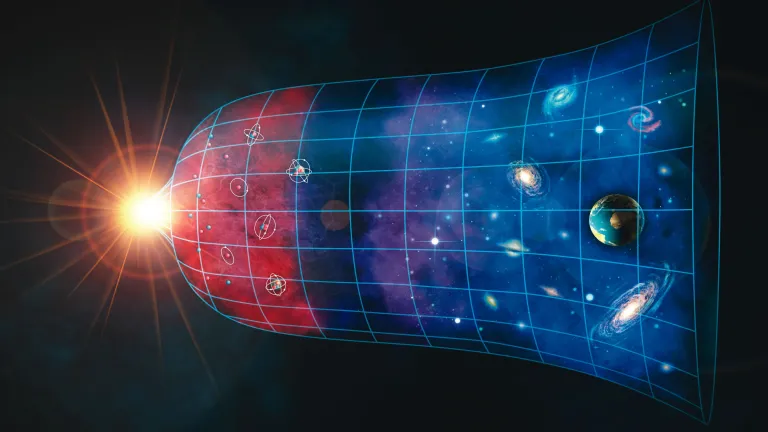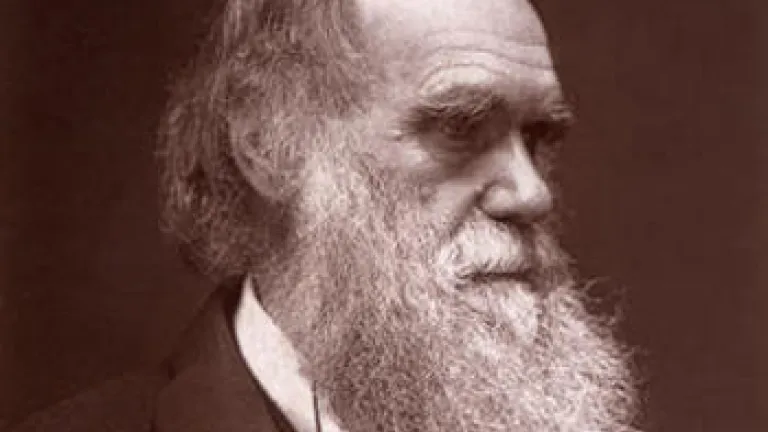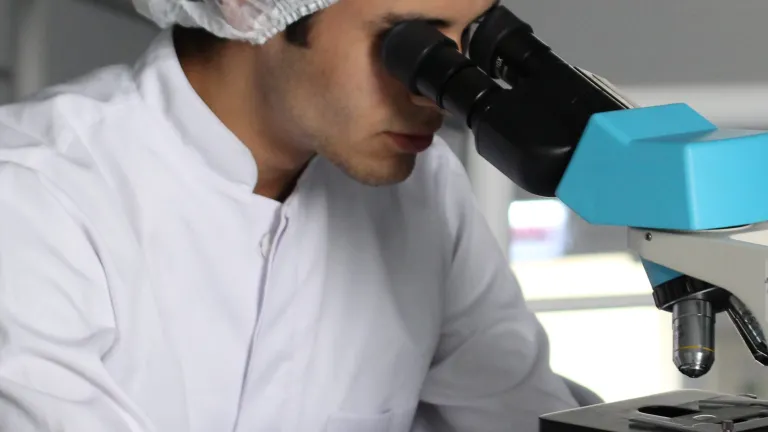Darwinism Unraveling

Charles Darwin’s theory of evolution is widely accepted throughout the world. How did that theory develop, and is it true?
This November marks the 160th anniversary of the publication of Charles Darwin’s landmark work On the Origin of Species. Its controversial premise popularized the idea that the vast variety of life forms we see in the world around us diverged from a single or small pool of common ancestors as a result of the survival and reproduction of offspring with advantageous traits—termed natural selection.
Over time, the book slowly but surely found its way into the foundational tenets of the biological sciences in modern academia. It’s difficult to find a professor or student of biology today who doesn’t accept the theory of evolution. In fact, acceptance of evolution by natural selection, also known as Darwinism, is often used as a litmus test in academia to prove one’s allegiance to science over myth.
However, as technology has advanced and science is able to understand more and more about DNA and the microbiological world, discoveries are being made that have begun to unravel Darwin’s theory. A number of scientists—both believers in God and non-believers—have concluded that Darwin’s explanation is simply not adequate to explain the levels of complexity seen in the natural world.
In recent years, scientists in the fields of biology, biochemistry and even psychology have presented strong evidence that challenges the academic status quo in biology—a house of cards 160 years in the making.
The proposal of slow, gradual change
In 1831, a young Charles Darwin boarded the H.M.S. Beagle and set sail on the adventure of a lifetime. For five years he served aboard as the ship’s naturalist. The 22-year old Darwin, fresh out of university, was provided extensive opportunities to explore vast tracts of South America and the Galapagos Islands, Australia and New Zealand, and a number of other remote locales around the world, cataloging and observing flora, fauna and fossils.
Just a year earlier, in 1830, Charles Lyell published the first volume of his groundbreaking work Principles of Geology, which popularized the idea that the processes shaping the earth today are the same as they were in eons past. He believed we can therefore extrapolate past conditions by observing rates and degrees of change in the present.
This process was referred to as uniformitarianism. It was claimed that the slow processes of today, acting little by little over long periods of time, were responsible for the rise of mountain ranges, the erosion of canyons and the building up of islands.
Before Lyell’s work, it was commonly understood that the earth changed through “catastrophism,” which held that the earth’s geological variation was due to periodic large-scale catastrophic events, not slow, incremental change.
The idea of uniformitarianism turned the world of geology on its head, and was a great influence on Charles Darwin. During his time aboard the Beagle, Darwin devoured Lyell’s book.
On a stop in Valdivia, Chile, the crew of the Beagle experienced a serious earthquake and then, setting sail, witnessed the devastation it had wrought on the local villages and shoreline. Darwin and the crew observed one area where the land had shifted a full eight feet.
These observations, combined with Lyell’s ideas, led Darwin to eventually consider how uniformitarianism and natural biological laws and forces might have the same effect on species. He would later wonder whether the extreme diversity he observed in the flora, fauna and fossils of South America might be due not to large-scale changes over a few thousand years, but instead to small, incremental change driven by some natural process over millions of years.
Natural selection
Years after his voyage, Darwin eventually came to the idea of gradual evolutionary change. But what process or mechanism could cause this?
Darwin raised pigeons as a hobby and belonged to several pigeon-breeding clubs in England. He knew that pigeon groups changed through the artificial process of selective breeding—putting birds with desired characteristics together to produce more like them.
Darwin began to wonder if something similar occurred in nature. Could nature somehow be directing how organisms change over generations?
In his travels, he observed how animals produce more offspring than can survive. He observed how there is competition among those organisms over food, water and mates. And in time he thought about certain advantages enabling some to succeed above others. If those advantages could be passed from parent to offspring, then organisms would develop greater fitness for survival over many generations, as those with the beneficial adaptations survive and reproduce and those without them do not.
Here was a mechanism for evolution. He called it natural selection.
Darwin reconsidered many of his earlier observations in the Galapagos Islands in this light. He had learned that there was a large degree of variation among the beaks and body shapes of finches there.
Others would later take up the study of these finches. It was observed that certain beak types were prevalent on certain islands, and this appeared to have a direct correlation to the food type available. Beak types even appeared to be able to change based on food availability from island to island, seeming to imply that those birds not adapted to the food source available died out. Those with beneficial adaptations survived and reproduced to pass on these adaptations.
The finch variations would be used to show that species change, the conclusion being that, as Darwin had proposed, organisms change over generations, developing structural adaptations in response to changing environmental conditions through natural selection. (Yet it’s been pointed out that the changes among finches were fluctuations back and forth within limits rather than clear developmental progression.)
Such structural adaptation was understood to accommodate needed function.
Functionalism vs. structuralism in biology
Darwin came to see the world from a functionalist perspective.
For the better part of two centuries, biologists have approached questions regarding the nature of organic form from two opposing camps—the viewpoints of functionalism and structuralism.
A biological functionalist believes the order and structure in living organisms—a bird’s beak, a five-fingered limb—must have arisen as a result of a functional need. To functionalists, the primary organizing principle of biology is adaptation contingent on environmental causes.
Structuralism (also called formalism), on the other hand, maintains that laws of biological form operating within living systems, which include internal constraints, are at the core of the structure of organisms. Thus the various physical aspects of organisms are seen as limited to particular ranges of form.
As an example, consider an animal cell’s enclosing membrane, which controls transport into and out of the cell. It’s made up of a series of phospholipid molecules. Structuralists would argue that it has resulted from chemical and physical laws that allow only so many possibilities for its structure rather than following an undirected and unbounded process of adaptation.
Limitations according to natural law are observed in the folding of proteins, the DNA molecule, the organization of other chemical compounds and the formation of crystals. These can only be organized in so many ways. Structuralists argue that common structural patterns in various creatures—such as five-fingered limbs in various birds, reptiles, marine animals and mammals—are preset forms and not a result of function leading to structure.
Structuralism does allow for certain adaptation but explains it quite differently from functionalism, as we’ll see.
A house of cards
Functionalism, which lies at the basis of Darwinism, is the prevailing view in modern biological science today. But what if the entirety of the theory of evolution is based on a faulty assumption? What if the idea that organisms are driven to evolve in a random, non-directed response to external pressure is wrong? What, instead, predetermined internal factors drive molecular shape and organization at a cellular level, these being the actual basis for adaptation?
Dr. Michael Denton, biochemist and author of the books Evolution: A Theory in Crisis, Nature’s Destiny and Evolution: Still a Theory in Crisis, is a prominent proponent of structuralism. He writes:
“Of course, all structuralists accepted that organisms exhibit adaptations to serve external environmental conditions. But these were considered to be ‘adaptive masks,’ grafted as it were onto underlying ground plans or ‘primal patterns.’ Thus the great diversity of vertebrate limbs—fins for swimming, hands for grasping, wings for flying—are all modifications of the same underlying plan or pattern, which serves no particular environmental necessity” (“Two Views of Biology: Structuralism and Functionalism,” Evolution News, 2016).
Structuralists believe that adaptation exists, but not as fundamentally arising from environmental factors. Instead, internal factors such as genetics produce specific patterns that may sometimes be modified through natural selection leading to microevolution, or minor variation. This does not allow for structure emerging from random mutation and macroevolution.
Denton goes on to state with regard to Darwin’s finches: “From the emerging developmental genetic picture, it is now relatively easy to envisage how gradual adaptive fine-tuning of the expression patterns of a handful of genes could result in the different beak forms of the Galapagos finches we see today. The evolution of finch beaks requires no causal agency beyond natural selection. Some finch beaks proved advantageous; others, not.
“The lesson of the Galapagos, and all such cases of microevolution, is that cumulative selection will work its magic just so long as there is an empirically known or plausible functional continuum, at the morphological [structural] or genetic level, leading from an ancestral species or structure to a descendent species or structure” (“Evolution: A Theory in Crisis Revisited [Part One of Three],” Inference: International Review of Science, Oct. 15, 2014). That is, the beak form was there to start with and was gradually modified to something still similar.
This is significantly different from Darwinian evolution. Darwin proposed that small variations from one generation to the next over long periods would, through the process of natural selection, produce entirely new structures and new kinds of life forms, what is now known as macroevolution.
But, in a world of more primitive scientific thinking, Darwin didn’t realize many major problems with this line of thought.
Understanding of genetics and genetic mutation—which Darwinists would seize on as a means of species modification—did not come until later. And with this came the realization that, more often than not, such mutation is harmful, causing more problems than advantages. Furthermore, mutations are not always heritable. Sometimes a novel mutation, even a rare beneficial one, doesn’t pass to the next generation.
Now, Dr. Michael Behe, author of Darwin’s Black Box: A Biochemical Challenge to Evolution, presents a new realization in his book Darwin Devolves: The New Science About DNA That Challenges Evolution. He writes:
“Darwinian evolution proceeds mainly by damaging or breaking genes, which counterintuitively, sometimes helps survival. In other words, the mechanism is powerfully devolutionary. It promotes the rapid loss of genetic information. Laboratory experiments, field research, and theoretical studies all forcefully indicate that, as a result, random mutation and natural selection make evolution self-limiting. That is, the very same factors that promote diversity at the simplest levels of biology actively prevent it at more complex ones. Darwin’s mechanism works chiefly by squandering genetic information for short-term gain” (2019, pp. 37-38, emphasis in original).
From a DNA standpoint, the evolutionary process actually prevents the level of complexity evolutionists claim it can achieve. This ultimately reinforces the structuralist position.
Irreducible complexity disproves evolution
Dr. Behe earlier presented the issue of “irreducible complexity,” a term he coined after exposure to the foundation of the concept in other works, such as Dr. Denton’s book Evolution: A Theory in Crisis. It means that complex systems must have all components in place to function and be passed on to the next generation—that the components cannot come together gradually over multiple generations. That’s because there would be no advantage in non-functional alterations—and perhaps this would even be disadvantageous—so that such changes would not be passed on.
An example is what Denton pointed out about bird lungs. While most organisms have bellows-style lungs—where air goes in, gas transfer occurs and exchanged gases are exhaled as the “bellows” close—birds have circulatory lungs. These do not expand and contract like those of mammals or reptiles. Instead, air goes into the rear air sacs of the bird, then flows to the lung, and from the lung to the front air sacs, and then out. This happens without expansion and contraction of the lung itself. It is unilateral flow, efficient and complex.
This level of complexity could not have resulted from gradual random mutations over generations. It is an example of irreducible complexity. If bird lungs evolved over time, what would the transitional forms of birdlike creatures have done to breathe?
Is it probable that the functional need led to the structure in a series of random, non-directed mutations? Or is it more likely that predetermined structure led to the function? Clearly the latter.
Another example of irreducible complexity is the DNA molecule and its transcription and translation in the cell.
DNA replication, transcription and translation—the complex process of duplicating the DNA molecule, transcribing it into the messenger RNA (mRNA), and then translating this to amino acid sequences and protein synthesis—is another system that is irreducibly complex. Any random mutation in the process that doesn’t lead to the full system operating all together leads to a lack of protein synthesis and the likely death of the organism.
The system had to have been in place in its entirety from the beginning to account for its existence at all.
A designer and lawmaker
All of this implies some directing force.
Despite his stand for structuralism, Dr. Michael Denton, although he opposes Darwinian evolution, remains a staunch evolutionist. He doesn’t attribute the design he feels is implicit to a higher power, but thinks there must be a direction of some kind—some force calling the shots. He believes in a primal order that imparts the structure, and an adaptive order that modifies it as needed.
Dr. Michael Behe is an advocate for intelligent design. He believes that a designer exists who has created these patterns and forms—that designer being God.
If we accept that these scientists are correct in terms of structuralism being the paradigm through which we should view the world—recognizing that predetermined structure led to function—the only conclusion we can logically make is that someone or something established that structure to begin with. Someone or something dictated the natural laws causing proteins to fold in predictable ways, crystals to form in specific ways and genes expressing in certain ways.
Genesis 1 clearly states that God created the heavens and the earth. He designed and formed the moon and stars, the waters, the land, the plants and animals, and mankind in His image.
In Jeremiah 33:25, God declares that it was He who created order in the heavens and earth, establishing day and night—that He created the physical laws through which our universe operates.
This is the most reasonable explanation for all the evidence we see. Structure with intended function came from the mind and work of a supremely intelligent Creator. The Bible tells us of that Creator and of His plan for you and me as His special creation, the very children of God!






